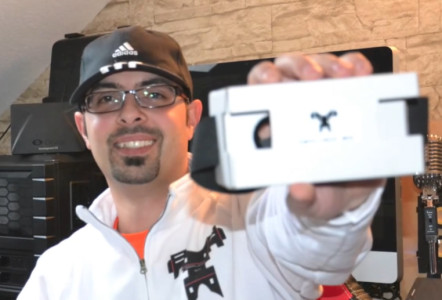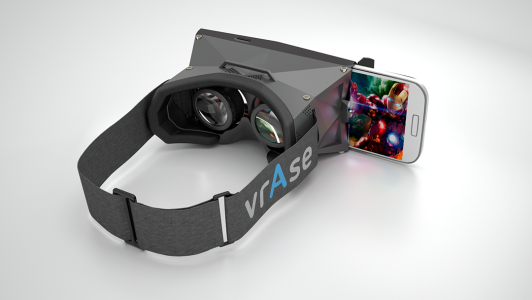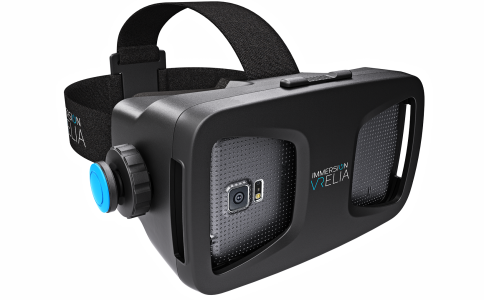Are you already preparing your smartphone to be your doorway to virtual reality? If no, it’s high time you did so. While virtual reality hardware keeps going three different paths, mobile platform is taking shape as the one with a huge potential to dominate eventually.
So don’t wait for the consumer version of the Oculus Rift to come out. Check out these reasons for trying out the mobile alternatives, which are either ready now or will soon be hitting the market.
1. They’re affordable
Prices start out at … well… free — if you happen to have a pizza box and a couple of old magnifying glasses lying garound. Introduced at the Google I/O keynote earlier this year, Google Cardboard specs are available free online.
For those a little less crafty, here are ten sites where you can buy Google Cardboard kits, with prices starting at under $10.
But even before Google Cardboard hit the market there were companies such as Refugio 3D, which is based in Germany, which began offering their version of a do-it-yourself virtual reality kit a year ago.
Their kit, which you assemble yourself, comes complete with cardboard, lenses, and foam edges, though not with the magnet and NFC chip that’s part of the Google Cardboard kits. It costs just 19.95 Euro plus tax and shipping.

“The sales are very successful,” Refugio 3D founder Claudio Panzanaro told Hypergrid Business. “There are daily orders from around the world.”
The device is a good way to get started with virtual reality, he said, with a number of games and apps already available for both the Android and iPhones that will work with the device.
And new vendors keeping entering the market. Most recently, noted lens maker Carl Zeiss joined in with their VR One headset for $99, due to arrive before the end of this year.
And Samsung’s Gear VR headset is already — according to reports – appearing in Best Buy stores. Maybe $200 for the headset is not exactly what affordable implies, since you need to have Galaxy Note 4 to be able to use it. However, such a diversity of choice of the headsets that can meet the demands of any customer only expands market coverage for the mobile virtual reality technology.
2. They work on many platforms
If a mobile device can show video in the virtual reality-friendly side-by-side format, it can be used inside a headset for immersive virtual reality.

The Kickstarter-backed vrAse headset, for example, is compatible with a wide array of smartphones with screens between 3.5 and 6.3 inches in size, including the iPhone 5, HTC One, Sony’s Xperia Z, and Samsung’s Galaxy S3, Galaxy S4 and Note 2.

The device will cost 99 Euro and be available in the next few months, company founder and CEO Miguel Schiaffino told Hypergrid Business.
Consumers will be able to play side-by-side formatted games on the device, watch movies as if they were projected on a giant screen, or use the device in combination with a PC or Mac, he said.
The vrAse has a software development kit for the game engine Unity3D, which is available for use by game developers.
However, the company is primarily focusing on the hardware development and technical improvement of the headset, so as to make the device comfortable to use by the end customers, Schiaffino said.
Another new headset, The GO, from ImmersiON-VRelia, is scheduled to arrive in November and will fit many smartphones, including Samsung S5, Note 4, Note 4, LG G 4, iPhone 6, iPhone 6+ and others.

“It is designed to adjust for different dioptrics — myopia or astigmatism — and eye separation, so the population segment is broad,†Manuel  Gutierrez Novelo, the co-founder of ImmersiON-VRelia, told Hypergrid Business.

The software for the headset is being developed by AlterSpace Augmented Virtual Reality, another of Novelo startup. AlterSpace is focusing on providing multi-platform, display-agnostic operating environments for creating virtual experiences applicable for different purposes from education to entertainment.
In the AlterSpace cloud-based and platform agnostic system, he said, a user can find immersive experiences like games, 360-degree videos, and public and private content.
“The AlterSpace Content can be developed by anyone using our software development kit,†he added. “And any content can be uploaded to the AlterSpace, so any user can enjoy it.â€
3. They can be used in many settings
The flexibility of the mobile platform, the wireless technology, the affordable prices all combined to make phone-based displays usable in a variety of different applications.
According to ImmersiON-VRelia’s Novelo, these are immersive environment where you can play — but also work, interact, learn, and more.
“The GO can be used for any application — aerospace, medical, training, education, simulations, entertainment, gaming, architecture, you name it,†he said.
In fact, especially in the beginning, games might not be the most successful use case for the mobile approach, especially games that require fast processing and excellent graphics.
“Top gaming computers are superior to mobile platforms,†said Refugio 3D’s Panzanaro. “But in a few years it can change. Soon it will be possible to use high quality games on smartphones.â€
Meanwhile, there is already demand for the mobile virtual reality technology from the non-game sector.
“I have already received inquiries related to medicine and architecture,” he said. “For these areas the use of Refugio 3D is possible too. Augmented and virtual reality will become a part of our lives.â€
4. They can be used for augmented reality
While virtual reality takes the user into a totally different world, augmented reality overlays images over what’s already there.
The best-known augmented reality system is Google Glass, but regular smartphones can do the job as well, if they have a camera on the back.
Refugio 3D is partnering with progressive3d GmbH to bring augmented reality experiences to their customers.
ImmersiON-VRelia’s AlterSpace also offers augmented reality as parts of an ecosystem that also includes virtual reality and artificial intelligence in its cloud-based platform.
And vrAse, as well, encourages developers to create augmented reality experiences, with a set of useful resources on their website.
However, mobile platforms do need to improve further to bring truly seamless augmented reality experiences to life, said vrAse’s Schiaffino. The smartphone’s processing power is not perfect, neither is the battery life, he said.
5. They evolve faster than other platforms
One major advantage of the mobile platform is its frequent updates. Oculus CTO John Carmack, in his speech at the recent Oculus Connect conference mentions that Samsung hardware refresh cycle is every six months.
By comparison, consoles upgrade every five to seven years and it takes PCs a few years, on average, to get their customers to make major updates to their hardware.
But mobile users will typically upgrade every year or two — or whenever they lose their phone or break it — which lets them keep up with advances in graphics and processing power.
“A good thing is that the smartphones will always get better, they won’t get worse,†said Schiaffino.
This rapid pace of evolvement puts mobile hardware technology on the leading edge of virtual reality adoption. Mobile virtual reality headsets are already seeking ways to work around the limitations of the mobile platform processing power, and will probably soon match of exceed that available in PCs.
Meanwhile, mobile headset manufacturers have to be ready to deal with mobile devices that come in a wide variety of configurations.
“Clearly, the mobile phone installed base platform is very diverse, and the smoothness of the experience depends on the phone,†said ImmersiON-VRelia’s Novelo. “Nevertheless, our software development kit has different profiles that can be configured and applied in real-time, depending on the phone hardware detected.â€
If the phone is not very powerful, he said, some parameters of the GO change automatically trying to compensate. There will be a change in polygons, or textures or optical corrections to maximize performance over quality.
“There will be a market for every platform,†said Novelo. “PC-based systems are good for some specific applications where high resolution polygons and fields of view like the ones we offer in our PRO version are not achieved on mobile platforms — not yet at least.â€
But definitely, he said, mobile virtual reality like the GO will proliferate faster due to portability and the current installed base.
- Virtual theater opens new doors for performance artists - August 27, 2015
- Virtual reality breathes life into immersive storytelling - January 11, 2015
- Virtual reality can make us nicer - November 22, 2014
